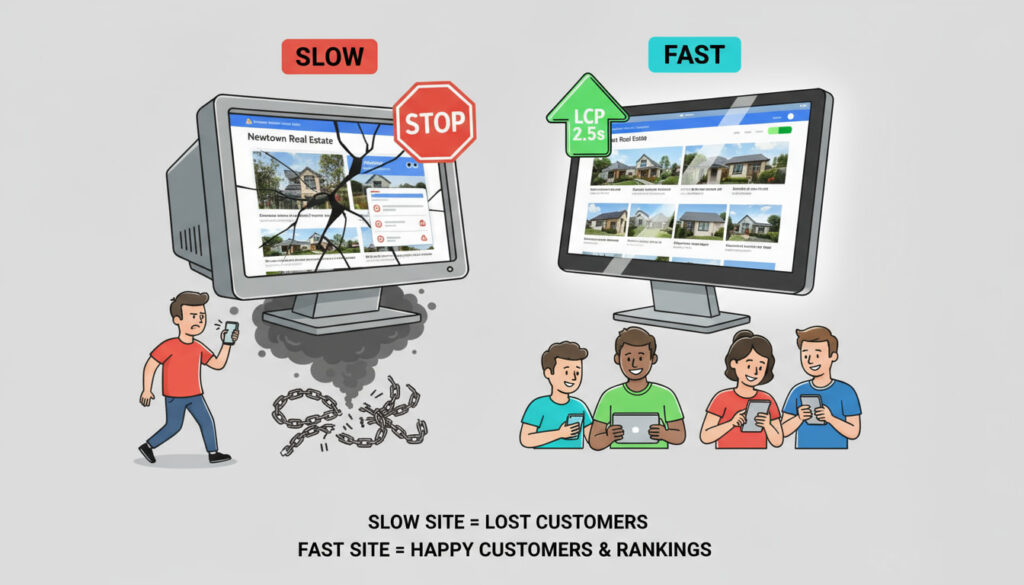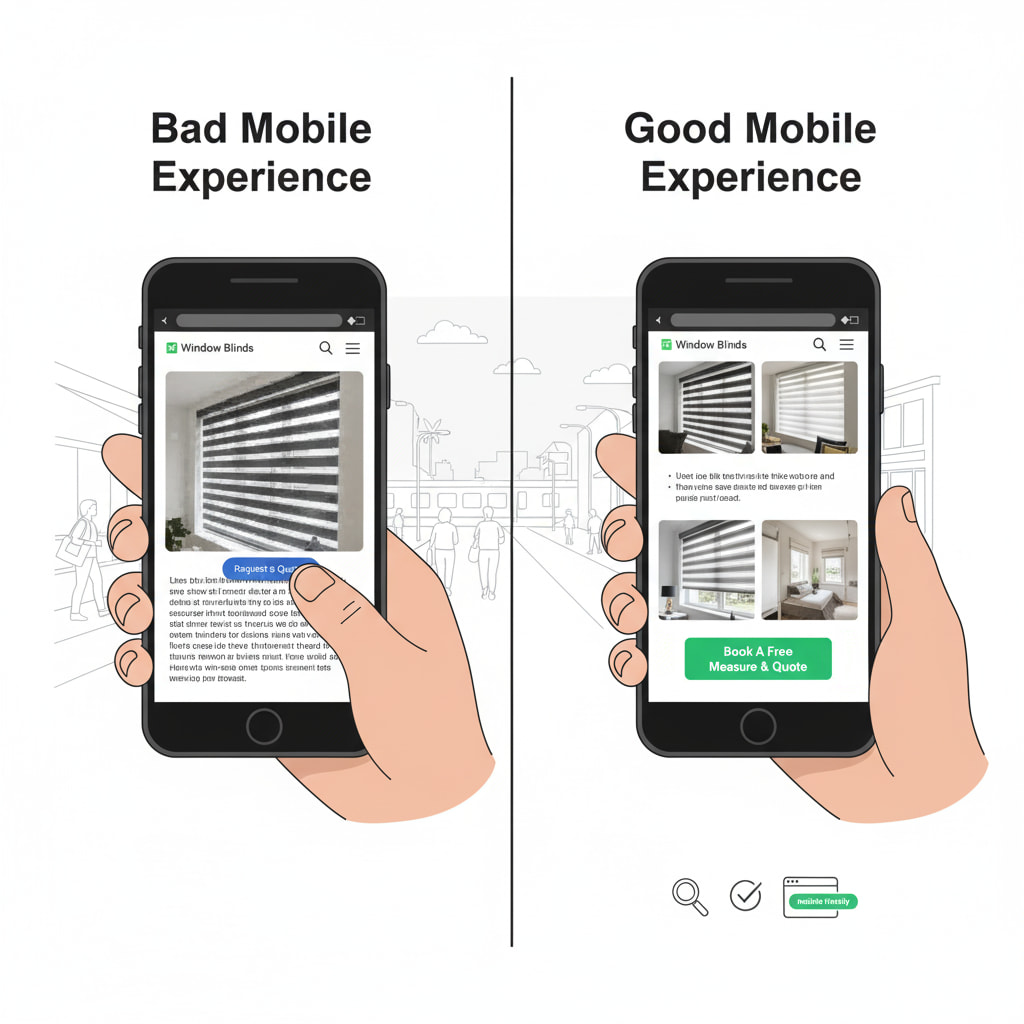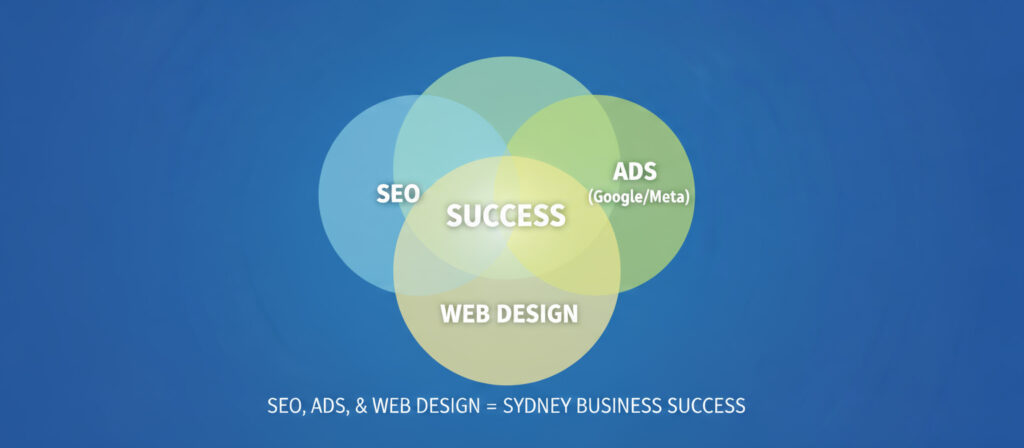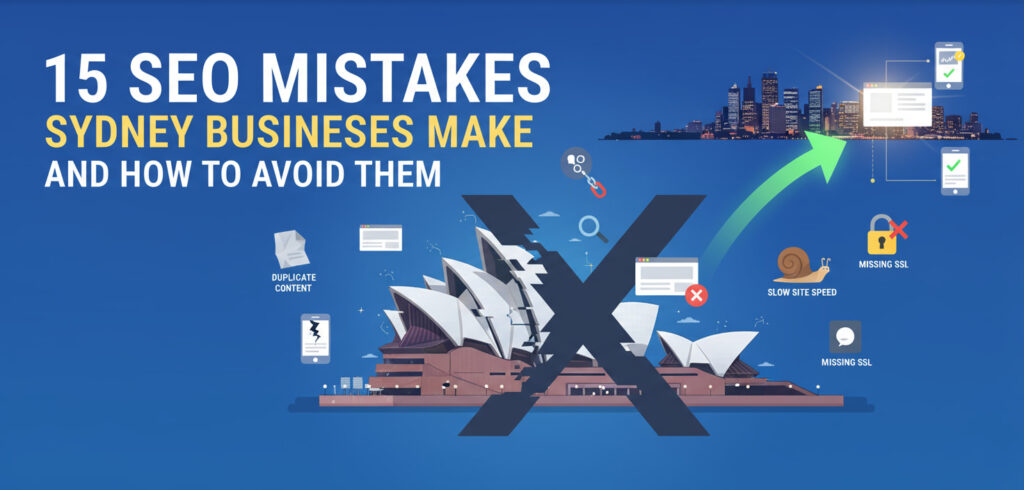Businesses that deliver exactly or more than what they promise are a breath of fresh, right?
Here is a challenge for you. Open a new tab on your browser and search “leaking shower repair expert Sydney” or any of the Eastern Suburbs. If you don’t find SealRITE Solutions as one of the top results, on the map pack and/or organic results, send us a screenshot of the results page and we will give your business $3,480 in the form of a full-site SEO audit packed with actionable insights and a 1,200 – 1,500 word optimised blog post completely FREE.
This is the confidence of an SEO strategy done right, by Sites By Design! Not through fancy hacks or guesswork but rather good old SEO foundations executed with surgical precision.
Why does this matter? Well, Sydney is crowded with competition. If your business doesn’t appear when someone searches for your services in the suburbs you serve, your competitor will take the call, the booking and close the sale. The upside is that most SEO slip-ups are fixable. By avoiding the common SEO mistakes that drag websites down, you can give your business the chance to be seen, trusted, and chosen by locals.
Sydney SEO wins are usually simple, not secret. Get the basics right: local SEO, site speed, metadata, and trackin, and you’ll outrank bigger brands in your suburb.
Why Sydney Businesses Can’t Afford SEO Mistakes
Search in Sydney is brutal. Your next customer is almost certainly typing into Google or ChatGPT before making a decision. Additionally, Sydney buyers search with suburb intent, often on mobiles and they compare fast. That means your visibility in Maps, local organic results and mobile UX directly affects bookings and sales. Seemingly small SEO mistakes (slow pages, clunky mobile layouts, missing suburb cues) compound into lost enquiries and sales.
Think about how your own customers search. They’re not just typing “plumber Sydney.” They’re pulling out their phone and searching “emergency plumber Parramatta” or “emergency dentist in Miranda”. Google then serves them a mix of ads, the map pack, and local organic results – and if you’re not visible there, you’re invisible to them. These hyper-localised searches mean you’re competing at both a city-wide and suburb level and it takes precision to get it right.
Sydney buyers are also impatient. A slow-loading website, clunky mobile layout, or lack of suburb-specific relevance is enough to make someone bounce and call the next listing. In a city this competitive, even a single SEO blind spot can tip the scales in your competitor’s favour – even when you have better products and services.
So, what are these common SEO mistakes and how can you avoid them?
Mistake 1: Ignoring local SEO and your Google Business Profile
Local SEO is the lifeblood of small and medium Sydney businesses. If your Google Business Profile (GBP) is incomplete or inconsistent, you’re giving competitors an easy win. Many owners either don’t claim their profile, forget to update details like opening hours, or leave out service areas. The result? You won’t show up in the map pack – one of the best tools that drives phone calls and directions straight from Google.
Take a plumber in Surry Hills for example. If their GBP lists accurate service hours, photos of past jobs, and consistent contact details across directories, they’re far more likely to appear when someone nearby searches “blocked drain expert Surry Hills.” By contrast, an unverified listing or one with mismatched contact details might not even show.
How do you optimise your Google business profile for local SEO?
- Verify GBP, pick accurate categories, add services, photos and updates
- Keep Name, Address, Phone consistent everywhere
- Create useful suburb pages for your core locations
- Add LocalBusiness schema and embed a clean map
- Ask customers for reviews and reply to each one
Google highlights relevance, proximity and prominence as important factors for local rankings. Keep data complete and build reputation with reviews and local links.
Mistake 2: Keyword stuffing and chasing the wrong terms
You’ve probably seen websites where every sentence feels like it was written for Google, not people: “If you’re looking for SEO Sydney, our Sydney SEO services are the best SEO in Sydney.” This is keyword stuffing, and it does more harm than good. Not only does it turn readers away, but Google also treats it as spam.
A better approach is to focus on search intent and local variations. If you’re an electrician in Bondi, people will search “Bondi electrician same-day service” or “electrician Bondi Junction after hours.” These specific queries are easier to rank for and more likely to convert than broad, competitive terms like “electrician Sydney.” By chasing intent-driven, suburb-specific searches, you get in front of people who are ready to buy without risking being blacklisted by Google for spamming.
How to choose the right keywords for local SEO:
- Map intent-based, location-aware phrases like: “emergency plumber Cronulla”, “family lawyer Chatswood”, “restaurant Newtown group bookings”
- Use natural synonyms and topics, not repetitions
- Anchor content to the searcher’s needs
Helpful tools for research: Google Search Console, Ahrefs keyword explorer, Semrush keyword research tools, .
Mistake 3: Neglecting technical SEO and slow site speed
Even if your site looks great, technical issues can bury it in the search results. A sluggish page is one of the biggest culprits. Research shows that if a page takes more than three seconds to load, most users leave – and in Sydney, where people are often browsing on mobile while commuting or out and about, patience is even thinner.
Consider a real estate agent in Newtown. If their property pages are slow because of oversized images and unnecessary scripts, locals looking for homes and rental spaces will hit the back button and pick a competitor whose website loads instantly. By compressing images, using proper caching, and trimming excess code, you can improve Core Web Vitals like Largest Contentful Paint (LCP), which directly influence rankings and user experience.
How do you increase your site speed?
- Monitor with PageSpeed Insights, GTmetrix and Google Search Console
- Compress and properly size images, enable lazy loading
- Minimise JS/CSS, defer non-critical scripts
- Use responsive images (
srcset)- Aim for LCP under 2.5s
- Consider CDN and reliable Aussie hosting

Mistake 4: Duplicate content and thin suburb pages
Copy-pasting the same content across multiple suburb pages is another common SEO mistake. By duplicating content across pges, Google can’t tell which page to prioritise, so none of them perform well. Thin, repetitive content also signals low value to both users and search engines.
If you service multiple suburbs, don’t just swap the suburb name in identical paragraphs. Instead, tailor each page with real context: photos of jobs completed, customer testimonials from locals, or references to council rules. For example, a builder in Surry Hills could highlight experience with terrace renovations, while the same builder’s Parramatta page might discuss larger family homes and council approvals. This way, every page feels authentic and useful.
How do you create high value content for local SEO in Sydney?
- Write genuinely unique suburb pages: local proof, projects, FAQs
- Use canonical tags where near-duplicates are unavoidable
- Add publish dates and keep pages updated
- Avoid “spun” text and doorway pages
Semrush and Google both stress helpfulness and uniqueness in titles and content.
Mistake 5: Missing or weak metadata
Your title tags and meta descriptions are the first thing people see in search results. Weak, duplicate, or missing metadata wastes that opportunity. A bland title like “Home” or “Services” tells neither Google nor your potential customer what to expect.
Instead, keep titles clear, concise, and location-aware. For example, “Emergency Plumber Parramatta | 24/7 Local Repairs” is far more powerful than “Plumbing Services.” Just be sure to be approximately 60 characters in length – a little over is fine. Meta descriptions should also entice clicks with specifics: “Fast, reliable plumbing services in Parramatta. Same-day callouts across Western Sydney.” These small tweaks can lift click-through rates significantly even before your actual rankings change.
How to create strong metadata (titles and descriptions) for local SEO:
- Keep titles ~55–60 characters with keyword + location near the front
- Write specific descriptions up to 155–160 characters, benefit-led
- Make every page unique, including blogs and suburb pages
Mistake 6: Not tracking SEO performance
You can’t improve what you don’t measure. Yet we often come across so many Sydney businesses that spend on SEO without tracking whether it brings in leads or sales. They might check a few rankings but ignore conversions entirely – which is like cheering for your team without watching the scoreboard.
The smarter move is to set up Google Analytics 4 and Google Search Console, then track calls, form fills and bookings. For example, a family attorney in Chatswood should know not just how many people visit their site, but also how many people book a callback online or schedule an appointment. By building reports that focus on real business outcomes, you’ll see clearly which efforts are working and where to adjust.
What should you track to measure SEO success?
- Leads and sales from organic (calls, forms, bookings)
- Core pages and suburb landing page performance
- Map pack actions (calls, directions) via GBP
- Build a simple Looker Studio dashboard
Rankings don’t pay the bills – leads and sales do. Track calls, bookings and enquiries to measure true SEO success.
Mistake 7: Overlooking mobile users and on-the-go searches
Google uses mobile-first indexing, which means that the mobile version of your site matters most. In Sydney, where many searches happen on the train, on job sites, or while walking down the Street, a clunky mobile site is a deal-breaker.
Imagine a window blinds manufacturer and installer in Bondi Junction. If their mobile catalogue is hard to tap, the ‘request a quote’ button is hidden or the product images require pinching and zooming, visitors will abandon it. On the other hand, a clean, responsive layout with a visible “Book A Free Measure & Quote” button encourages quick action. Mobile optimisation is not optional – it directly affects both rankings and revenue.
Quick ways to optimise your site for mobile users:
- Responsive layouts, large tap targets
- Sticky call button and short quote forms
- Trim pop-ups, keep copy scannable
- Test with Google’s mobile tools

Mistake 8: Weak content strategy and poor internal linking
Many Sydney businesses fall into the trap of publishing random blogs without a clear plan. This scattergun approach dilutes authority and leaves visitors (and Google) confused about which pages matter most. Without internal links, valuable content sits in isolation, never boosting the service pages that drive enquiries.
A better strategy is to build topic clusters. For example, a home renovation company could have a core page for “Bathroom Renovations Sydney,” supported by blogs such as “Cost of Bathroom Renovations in Parramatta” or “Design Ideas for Small Bathrooms in Surry Hills.” Each blog should link back to the main service page and also cross-link to each other. This structure signals to Google that your site has depth and authority and it helps users easily find related content.
How to build topic clusters for SEO:
- Build a pillar page on your main service, e.g. “Bathroom Renovations Sydney”
- Create support blog posts: cost guides, checklists, suburb case studies
- Link from each post to the pillar and to relevant suburb pages
- Use descriptive anchor text, not “click here”
Strong internal linking turns scattered blogs into a network of authority. It tells Google, and your customers, which pages matter most. Ahrefs also highlights internal links as a powerful, controllable ranking lever on their internal linking guide.
Mistake 9: Ignoring search intent
Not all keywords are equal. Some are informational (“what is SEO”), others are transactional (“same day sparky in Bondi”), and some are in between. Many Sydney businesses target keywords without considering what the searcher actually wants – search intent. The result is content that ranks poorly or attracts visitors who never convert.
If you’re a lawyer in Chatswood, targeting “what does a family lawyer do” may bring traffic, but not necessarily new clients. Targeting “family lawyer Chatswood free consultation” is more likely to convert because it matches a user’s intent to take action. Before creating any page or blog, always check what appears in the search results, if it’s mostly guides, write a guide; if it’s mostly service pages, make sure your service page is optimised to compete.
What is Search Intent?
Search intent refers to the purpose behind a user’s search query. It explains what the person hopes to achieve when they type something into Google or any other search engine.
Mistake 10: Forgetting image SEO and media optimisation
Images are often the heaviest elements on a page, and unoptimised files can cripple your load speed. Beyond that, many businesses forget that images themselves can be a source of traffic when properly optimised.
Every photo you upload should be compressed, saved in a web-friendly format like WebP, and tagged with descriptive alt text. For instance, if you’re showcasing a kitchen renovation in Surry Hills, don’t label the photo “IMG_1234.” Instead, use “modern kitchen renovation Surry Hills” as the alt text. This not only helps Google understand your content but also makes your images discoverable in Google Images, opening another path for customers to find you.
How to optimise images and media
- Export at the right dimensions, use WebP/AVIF where possible
- Add concise, descriptive alt text
- Use captions sparingly where helpful
- Lazy-load below-the-fold media
Mistake 11: Skipping reviews and local trust signals
Reviews are a powerful ranking and conversion signal In Sydney’s competitive suburbs. Yet we still come across many businesses that don’t actively collect them, leaving their profiles looking bare compared to rivals with dozens of glowing testimonials. Google considers reviews as part of prominence in local SEO, and customers rely heavily on them when deciding who to call.
What is Prominence in Local SEO?
Prominence refers to how well-known your business is, both online and offline. Businesses that are more recognised tend to appear higher in local search results. This is influenced by signals like backlinks from other websites, the number of reviews, and overall ratings. More reviews and positive feedback can improve your local rankings.
A chiropractor in Blacktown who has fifty positive reviews mentioning “Blacktown” will almost always outrank one with only a handful of generic reviews. The fix is simple: ask customers directly after each job, provide a short review link and reply to each review with gratitude. Mentioning suburbs naturally in your replies can further reinforce your local relevance. Make sure you also showcase snippets on suburb pages and your GBP
Reviews are more than social proof – they are a local SEO ranking factor. The more suburb-specific feedback you earn, the more visible you become.
Mistake 12: Using unfriendly URLs and messy site architecture
Long, confusing URLs packed with numbers and parameters not only look untrustworthy but also make it harder for search engines to understand your site. A clean structure helps both users and Google navigate your content.
For example, instead of “https://example.com/page?id=123&cat=plumbing“, use “https://example.com/plumbing/emergency-parramatta.” A clear hierarchy also matters. Group service areas logically under a parent page, such as /sydney/parramatta/ or /sutherland-shire/cronulla/. This helps search engines map your service coverage and prevents orphan pages that never get indexed.
Mistake 13: Indexing issues and crawl errors
You can’t rank if your pages aren’t indexed. However, many Sydney sites unknowingly block Google from crawling pages or leave critical content orphaned. Issues like accidental “noindex” tags, broken internal links, or outdated sitemaps can stop important pages from ever appearing in search results.
A quick way to check is to type site:yourdomain.com into Google and see how many pages appear. If key service or suburb pages are missing, it’s time to investigate with Search Console. Submitting an updated sitemap, fixing redirects and ensuring internal links point to your money pages are the first steps in solving indexing problems.
Mistake 14: Hiring the wrong SEO agency
Sydney is not short of SEO agencies making big promises on how they can help your business rank number one on search results. unfortunately, many businesses waste money on providers who deliver little more than jargon and reports. Some use black-hat tactics like buying cheap backlinks or spinning content, which may work briefly but usually lead to penalties or long-term setbacks.
When choosing an SEO agency, look for transparency, local knowledge and reporting that ties SEO efforts to real business outcomes. For instance, a good agency should show you not only how your rankings are improving in Randwick or Paddington but also how that visibility is translating into phone calls, enquiries and revenue.
If you’re looking for SEO grounded in Sydney’s reality, a trusted SEO agency like Sites By Design that is actively helping real businesses reach real customers from Cronulla to Richmond, Campbelltown to Hornsby and everywhere in between will understand the local nuances that many generic providers miss.
A good SEO partner doesn’t just talk rankings – they show you the calls, bookings and sales those rankings generate.
Mistake 15: Treating SEO in isolation from ads and web design
Some Sydney businesses treat SEO as a stand-alone, one and done project, separate from their other marketing channels. In reality, the best results come when SEO, Google ads/Meta Ads and web design work together.
For example, Google Ads can capture immediate demand for “emergency electrician Surry Hills,” while SEO builds long-term visibility for “electrician Surry Hills” and related searches. However, both efforts will struggle if your website is slow, outdated or confusing. A fast, mobile-friendly design ensures that whether traffic comes from organic search or ads, it actually converts. Treat SEO as part of a bigger ecosystem, not a silo.

SEO Success In Sydney Is As Simple As Avoiding Mistakes
Sydney’s search market rewards the businesses that keep things simple but disciplined. The fastest way to grow visibility isn’t to chase secret hacks, but rather to avoid the common SEO mistakes that hold so many local businesses back. Whether it’s missing suburb cues, slow pages, weak metadata, or choosing the wrong agency, each SEO mistake compounds into lost opportunities.
If you’ve recognised some of these SEO mistakes in your own site, you’re not alone – most Sydney businesses make them. The difference is whether you fix them now or let your competitors continue to win.
By fixing these, you don’t just improve rankings – you make it easier for Sydney customers to find you, trust you and book you.
If you’re ready to tighten up your SEO and want local expertise that understands how people across Sydney actually search, it’s time to get help from a Sydney SEO agency that knows your backyard.
Don’t let your next SEO mistake be not reaching out to Sites By Design, your trusted SEO agency in Sydney, to tighten your SEO strategy, refine your suburb targeting and build a content strategy that keeps enquiries coming. Our SEO services in Sydney speak for themselves.
FAQs on SEO Mistakes Sydney Businesses Should Avoid
1. What are the most common SEO mistakes Sydney businesses make?
The biggest SEO in Sydney are ignoring local SEO, keyword stuffing, slow websites, weak content strategies, poor mobile design, duplicate content, and not tracking results. Many of these are easy to fix with the right process.
2. Why does local SEO matter so much in Sydney?
Sydney searches are highly suburb-driven. Someone searching “plumber Castle Hill” wants a local provider, not one across town. If your site and Google Business Profile don’t signal your location clearly, you’ll lose out to competitors who do.
3. How can I tell if my site has technical SEO issues?
Use tools like Google Search Console, PageSpeed Insights, or Screaming Frog. Look for crawl errors, slow loading times, missing SSL certificates, broken links, and poor mobile usability.
4. How long does SEO take to work in Sydney?
Small technical fixes can bring improvements within weeks. But building authority through content and backlinks usually takes 3–6 months, depending on your competition and budget.
5. What happens if I stuff too many keywords into my content?
Keyword stuffing looks spammy, reduces readability, and can even trigger Google penalties. Use suburb-specific terms naturally (like “Electrician Bondi”) alongside synonyms, but always write for people first.
6. Can duplicate content really hurt my rankings?
Yes. If multiple pages repeat the same text, Google struggles to know which to rank, and authority gets diluted. Always write unique content for each service or suburb page.
7. Do reviews help SEO in Sydney?
Absolutely. Reviews not only build trust with customers but also feed into Google’s local ranking signals. A business with dozens of suburb-specific reviews will often outrank one with none.
8. What’s the safest way to build backlinks?
Earn them naturally by publishing helpful content, partnering with local organisations, or contributing to local media. Avoid buying links or joining link schemes, as these can trigger penalties.
9. How do I know if my pages are indexed?
Search site:yourdomain.com in Google. If key pages are missing, check for technical issues like “noindex” tags or missing sitemaps, and use Search Console to request indexing.
10. Is site speed really that important for rankings?
Yes. Google uses Core Web Vitals like loading speed and stability as ranking signals. More importantly, Sydney users expect fast websites, if your site takes more than three seconds to load, most will leave.
11. What’s the best way to measure SEO success?
Rankings alone aren’t enough. Track traffic, leads, calls, and sales from organic search. A good SEO agency in Sydney should show how your suburb visibility translates into real business outcomes.
12. Should SEO be managed in-house or outsourced?
Some basics, like updating metadata or posting blogs, can be done in-house. But for long-term strategy, technical fixes, and staying ahead of competitors, a trusted Sydney SEO agency is usually the smarter choice.
13. Why is mobile SEO critical in Sydney?
Most Sydney searches happen on mobile. If your site isn’t responsive or loads slowly on 4G, you’ll lose enquiries to competitors with smoother mobile experiences.
14. What’s the role of internal linking in SEO?
Internal links guide Google through your site and show which pages are most important. For example, blogs about “Restaurant Marketing in Newtown” should link back to your main Sydney marketing services page to build authority.
15. What’s the cost of ignoring SEO mistakes in Sydney?
The cost is hidden in lost opportunities. If you’re not visible when someone searches “best injury attorney in Surry Hills” or in our case “SEO agency in Miranda,” a competitor is winning the clicks, bookings, and revenue that could have been yours.

